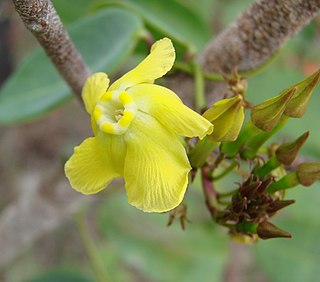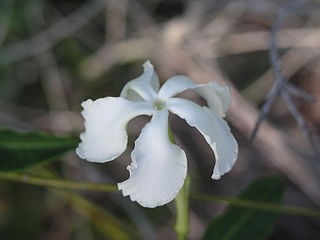
Apocynaceae is a family of flowering plants that includes trees, shrubs, herbs, stem succulents, and vines, commonly known as the dogbane family, because some taxa were used as dog poison. Members of the family are native to the European, Asian, African, Australian, and American tropics or subtropics, with some temperate members. The former family Asclepiadaceae is considered a subfamily of Apocynaceae and contains 348 genera. A list of Apocynaceae genera may be found here.

Psidium is a genus of trees and shrubs in the family Myrtaceae. It is native to warmer parts of the Western Hemisphere.

Oncidium, abbreviated as Onc. in the horticultural trade, is a genus that contains about 330 species of orchids from the subtribe Oncidiinae of the orchid family (Orchidaceae). As presently conceived, it is distributed across much of South America, Central America, Mexico and the West Indies, with one species (O. ensatum) extending into Florida. Common names for plants in this genus include dancing-lady orchid and golden shower orchid.

Myrceugenia is a genus of evergreen woody flowering trees and shrubs belonging to the myrtle family, Myrtaceae, first described as a genus in 1855. The genus is native to South America from central Brazil to southern Chile. It is closely related to the genus Luma; some botanists include Myrceugenia in that genus.

Plumeria is a genus of flowering plants in the family Apocynaceae. Most species are deciduous shrubs or small trees. The species variously are endemic to Mexico, Central America and the Caribbean, and as far south as Brazil and north as Florida, but are grown as cosmopolitan ornamentals in warm regions. Common names for plants in the genus vary widely according to region, variety, and whim, but frangipani or variations on that theme are the most common. Plumeria is also used as a common name, especially in horticultural circles.

Tabernaemontana is a genus of flowering plants in the family Apocynaceae. It has a pan-tropical distribution, found in Asia, Africa, Australia, North America, South America, and a wide assortment of oceanic islands. These plants are evergreen shrubs and small trees growing to 1–15 m tall. The leaves are opposite, 3–25 cm long, with milky sap; hence it is one of the diverse plant genera commonly called "milkwood". The flowers are fragrant, white, 1–5 cm in diameter.

Mandevilla is a genus of tropical and subtropical flowering vines belonging to the family Apocynaceae. It was first described as a genus in 1840. A common name is rocktrumpet.

Hieronyma is a genus in the plant family Phyllanthaceae. It was first described as a genus in 1848. This family was formerly united with spurges, crotons, copperleaves, etc. (Euphorbiaceae), but have turned out to be well distinct. The genus is native to South America, Central America, southern Mexico, and the West Indies.

Cascabela is a genus of flowering plants in the dogbane family, Apocynaceae. It is native to Mexico, Central America, and South America.
Forsteronia is a genus of plants in the family Apocynaceae, first described as a genus in 1818. It is native to South America, Central America, Mexico, and the West Indies.

Halodule is a genus of plants in the family Cymodoceaceae described as a genus in 1841. It is widespread on tropical and semi-tropical ocean shores of all continents except Europe and Antarctica.

Prestonia is a genus of plants in the family Apocynaceae, first described as a genus in 1810. It is native to Mexico, Central America, South America, and the West Indies. It is closely related to Artia and Parsonsia.

Cascabela thevetia is a poisonous plant native throughout Mexico and in Central America, and cultivated widely as an ornamental. It is a relative of Nerium oleander, giving it a common name yellow oleander, and is also called lucky nut in the West Indies.

Schizachyrium is a widespread genus of plants in the grass family. The name is derived from the Ancient Greek words σχίζειν, meaning "to split," and ἄχυρον, meaning "chaff." It refers to either the glume or the toothed lemmas.
Haplophyton is a genus of plants in the family Apocynaceae, first described in 1844. It is native to the southwestern United States, Mexico, Cuba, and Guatemala. It is a suffrutescent herb with alternative leaves and showy colorful flowers.

Echites is a genus of flowering plants in the family Apocynaceae, first described as a genus in 1756. It is primarily native to Mexico, Central America, the West Indies, and the US State of Florida.
Pinochia is a genus of plants in the family Apocynaceae, first described as a genus in 2007. It is native to Central America, Mexico, and the West Indies.

Mesechites is a genus of plants in the family Apocynaceae first described as a genus in 1860. It is native to Mexico, Central America, South America, and the West Indies.
Vallesia is a genus of plants in the family Apocynaceae first described as a genus in 1794. It is native to South America, Central America, Mexico, Florida, Galápagos, and the West Indies.

Fischeria is a plant genus in the family Apocynaceae, first described as a genus in 1813. It is native to South America, Central America, southern Mexico, and the West Indies.

















